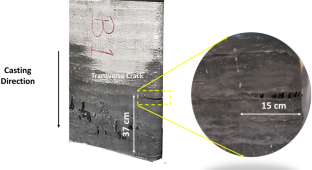Journal of Materials Science ( IF 4.5 ) Pub Date : 2024-04-16 , DOI: 10.1007/s10853-024-09625-1 Mohamed Qassem , Daniel Larouche , Mousa Javidani , Josée Colbert , X.-Grant Chen

|
A comprehensive investigation, encompassing microstructural analysis of the subsurface and bulk regions, along with tensile testing near the solidus temperature in the range of 520–580 °C and with two strain rates (10–4 and 10–3 s−1), was conducted on two AA5182 alloy ingots (A and B) cast at casting speeds of 60 and 75 mm \(\bullet\) min−1, respectively. Microstructural analysis revealed an equiaxed grain structure throughout Ingot A, whereas Ingot B transitioned from an equiaxed structure in the subsurface to a columnar grain structure in the bulk region. Regarding intermetallic phases, Ingot A showed predominant Al6(Fe,Mn), whereas Ingot B exhibited a high amount of needle-like Al3Fe. Consequently, Ingot A exhibited superior semisolid tensile properties compared to Ingot B at the given test temperatures. The difference between the two ingots became pronounced at the low strain rate of 10–4 s−1, with the brittle temperature range (BTR) values of Ingot B higher than those of Ingot A. An assessment of the hot-tearing susceptibility (HTS) using the BTR criterion revealed that the HTS of Ingot B was higher than that of Ingot A, confirmed by the occurrence of a large transverse macrocrack during the direct-chill casting of Ingot B.
中文翻译:

直冷铸造AA5182合金在固相线温度附近的半固态拉伸性能及其热裂敏感性
一项全面的研究,包括地下和本体区域的微观结构分析,以及在 520-580 °C 范围内的固相线温度附近和两种应变速率(10 –4和 10 –3 s -1)下进行的拉伸测试。在分别以 60 和 75 mm \(\bullet\) min −1的铸造速度铸造的两个 AA5182 合金锭(A 和 B)上进行。微观结构分析显示,整个铸锭 A 具有等轴晶结构,而铸锭 B 从表面下的等轴结构转变为块体区域的柱状晶结构。关于金属间相,锭A显示出主要的Al 6 (Fe,Mn),而锭B显示出大量的针状Al 3 Fe。因此,在给定的测试温度下,与锭 B 相比,锭 A 表现出优异的半固态拉伸性能。两种铸锭之间的差异在 10 –4 s -1的低应变速率下变得明显,其中铸锭 B 的脆性温度范围 (BTR) 值高于铸锭 A 的值。热撕裂敏感性 (HTS) 的评估)使用 BTR 标准表明,铸锭 B 的 HTS 高于铸锭 A,这通过铸锭 B 直冷铸造过程中出现的大的横向宏观裂纹得到证实。



























 京公网安备 11010802027423号
京公网安备 11010802027423号